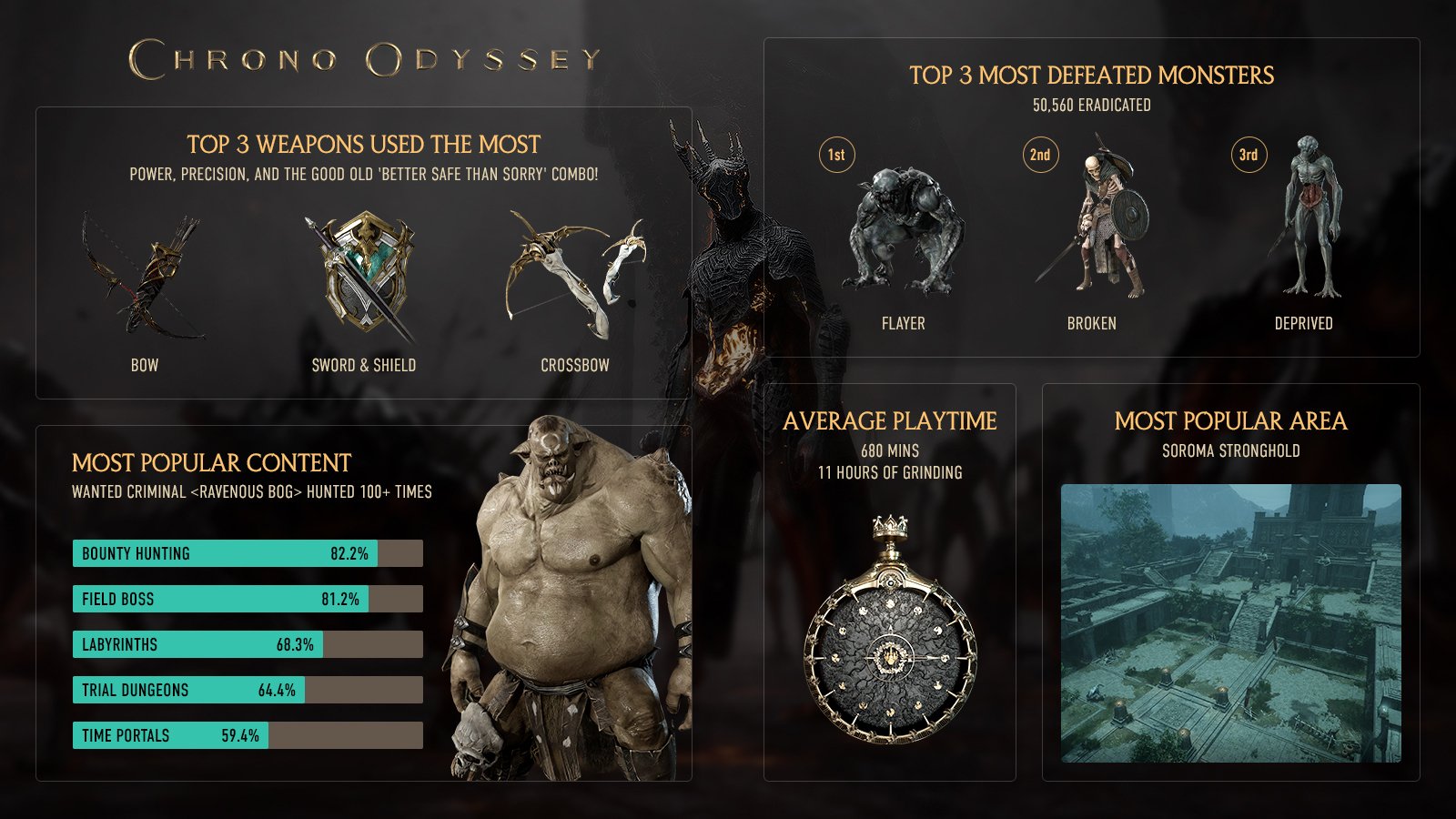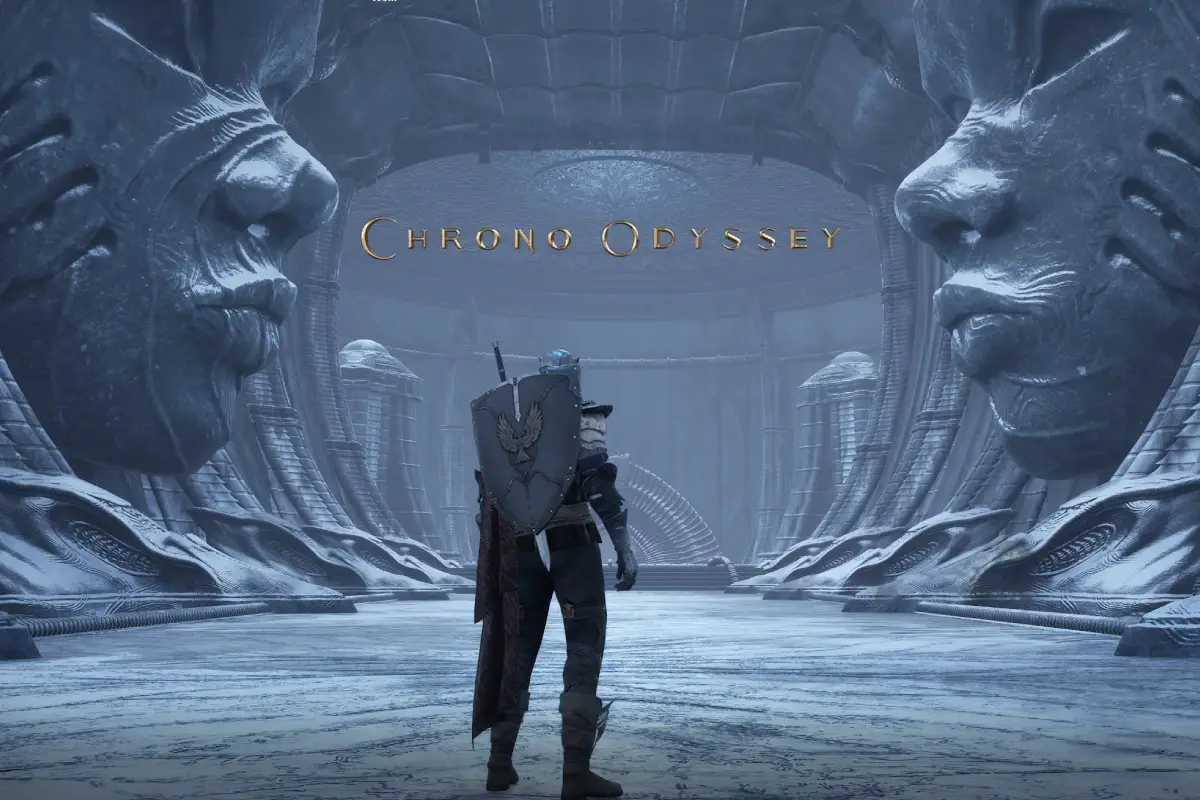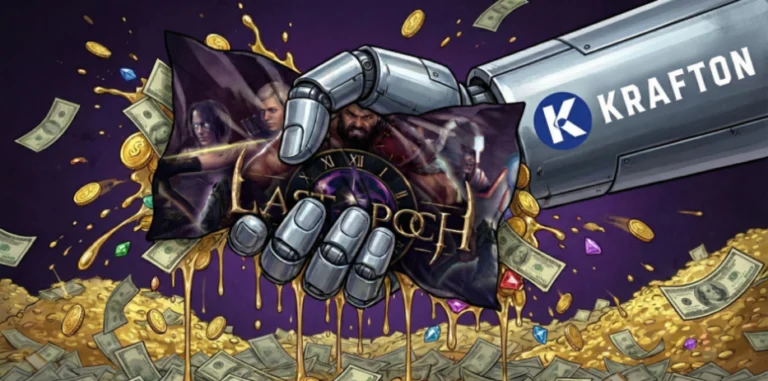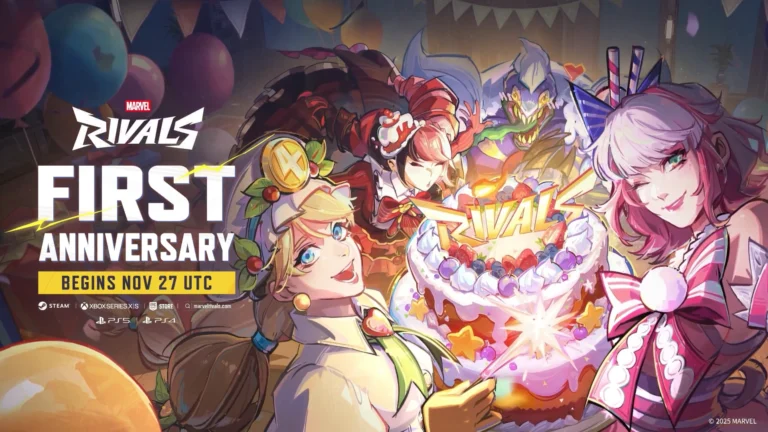The Chrono Odyssey team released an in-depth statement today within their Discord regarding some of the data they’ve collected during and after the first Closed Beta Test (CBT). They also showcased a handful of categories that they’ve heard feedback on and shared some of the major changes they’ll be making to address this. For an in-depth look at the official Chrono Odyssey Developer’s Note, click here.
General Player Statistics & Data
The Developer’s Note starts off by referencing the Focus Group Test they had back in February and shared some interesting statistics about the top three weapons most used, the most defeated monsters, average playtime, most popular content, and more (see below).

Please note: This data is specific to the Focus Group Test that happened in February. We expect to see an updated version of this graphic for the first CBT soon.
Based on this first sample size, it was interesting to see that “Bounty Hunting” was the most popular activity for these testers. This may likely be due to the fact that bounties are solo-based content and can be done somewhat quickly when compared to some of the other activities listed. It will be very interesting to see how this smaller sample size compares to the large sample size of the first CBT (fingers crossed the team shares an updated graphic soon)!
Major Changes Coming to Chrono Odyssey
The team then shared the following statement:
“We want to thank everyone who joined the recent closed beta. Your support, curiosity, and genuine feedback have meant a lot to us. It’s been a privilege to watch players explore what we’ve built so far, and your input allows us to take an honest look at where the game stands and shape our next steps.
We were excited to see that many of you enjoyed the core experience of Chrono Odyssey. However, there are also areas that fell short. We heard consistent feedback on animations, motions, combat responsiveness, performance, optimization, graphics, etc. All forms of critique, whether big or small, are critical to the development process, and our top priority is to address these shortcomings accordingly.”
The following three areas were then focused on, with a promise that additional areas and updates will be shared soon:
- Animations & Combat Responsiveness
- Performance & Optimization
- Graphics
Each of these categories, and their respective updates can be found below.
Animations & Combat Responsiveness
The following four areas within this category were focused on – each including direct updates/fixes that the team plan on implementing prior to the next CBT.
1.) Hit Feedback Inconsistency
- This was a major issue during the closed beta test. Some actions felt sluggish or disconnected, with attacks, dodges, and blocks occasionally failing to register as expected. We believe this stems from packet desyncs between the client and the server, and will accelerate packet transmission to improve timing accuracy, redesign packet intervals, and refine the packet structure.
- Currently, motion and combat packets are interconnected in a shared data stream, which may be contributing to sync issues. We plan on separating these into distinct systems, actively reviewing and resolving all collision detection inconsistencies to ensure combat interactions feel consistent and responsive.
2.) Class Weapons
- While each class has a wide range of abilities, we’ll be introducing a new system called the “Matrix” in the next test to give each weapon a more distinct identity. This system will allow you to choose from four progression paths per weapon (twelve in total) as each class has three weapons.
- We aim to diversify skill usage of each weapon based on progression paths. Even if two players are using the same weapon, their primary skills may differ. The same skill can also produce different results depending on builds. Our goal is a wide range of playstyles, whether you’re focusing on chaining skills, switching between weapons, or exploring other tactical options. Farming will become more dynamic, and players will need to find gear with stats that match their playstyle.
- With added playstyles, we’re creating new animations to ensure each weapon feels distinct and expressive in combat.
3.) Camera
- We are fixing an issue where the camera angle affects visibility when you’re too close to walls or certain environments.
- The following issues with the lock-on system will also be addressed:
- Abrupt screen change when changing targets
- Camera getting too close to the target during melee combat
- Camera reset after combat
- Skills being cast based on the direction the player is facing rather than the camera’s view.
- We’re also addressing an issue where the camera shakes vertically in certain areas.
4.) Controls
- To enhance the overall feel of combat, we’re redesigning hit reactions by increasing the reaction duration from 1 to 2-4 seconds. This provides clearer timing for follow-up attacks and adds a greater sense of risk and reward when taking damage or landing hits.
- We’re also reviewing and fixing unnatural character movements and collision inconsistencies that caused characters to appear as if floating.
Performance & Optimization
The following four areas within this category were focused on – each including direct updates/fixes that the team plan on implementing prior to the next CBT.
1.) GPU & Rendering Overload
- We’re restructuring how assets are rendered to reduce GPU load and improve real-time performance.
- High-resolution Nanite geometry will only be applied where necessary, while frequently repeated assets will rely on Instanced Static Mesh (ISM) or Hierarchical Instanced Static Mesh (HISM) to minimize draw calls and reduce GPU strain. Assets will be managed in batches, and draw calls will be consolidated to minimize CPU–GPU communication overhead and maximize rendering efficiency.
2.) Development Efficiency
- We’re shifting level design toward reusable environmental assets to improve development efficiency and runtime performance to speed up production and simplify maintenance, while reducing memory, disk, and rendering overhead.
- We’re also minimizing redundant materials and textures by standardizing our art pipeline with trim sheets, ensuring high-resolution visual variety.
▶ Trim sheets?
Trim sheets consolidate commonly used detail elements (such as metal edges, moldings, panel lines, and bolts) into a single texture laid out within a 0–1 UV space. Each asset is then UV-mapped to the appropriate section, allowing for a wide range of visual details using just one shared material. This eliminates the need to create separate high-resolution textures for every object. In Unreal Engine, trim sheet–based materials are loaded only once, which reduces memory usage and optimizes draw calls. By instancing parameters like color, roughness, and metallic values, we can easily introduce visual variety without adding performance cost. Trim sheets are particularly effective when applied to modular environment pieces and background structures that are frequently used throughout the game world.
3.) Memory Usage
- We’re restructuring the loading system by separating rendering data from collision data to reduce memory usage and improve system stability.
▶ Collision data loaded alongside rendering data?
Previously, collision data was loaded alongside rendering data even when it wasn’t needed. With the new structure, only rendering data is loaded by default, while collision data is selectively loaded based on player proximity and line of sight, completely avoiding unnecessary memory usage. For Nanite meshes, we’re planning to replace per-polygon collision with simplified low-poly collision meshes to lower GPU and CPU overhead. Unused collision primitives will be unloaded from memory to further optimize resource usage and improve loading speed.
- We’ll be refining our Garbage Collection (GC) and memory allocation structure to manage unused areas more efficiently.
- Unused cells and actors within the World Partition system will be automatically unloaded, and the garbage collection timing will also be adjusted to remove unnecessary references more quickly.
- Resources will be managed based on their data layer state with only active layers remain loaded, while assets in inactive layers are prevented from loading altogether. This ensures that only relevant assets consume memory, resulting in better performance and system stability.
4.) Stable Performance Across Various System Specs
- We’ll be designing a dynamic loading system that adjusts based on the player’s hardware: high-end systems for broader areas and higher-quality assets, lower-end systems for nearby cells and lower-resolution assets. This ensures a balanced experience between performance and visual quality, regardless of system specs.
Graphics
The following three areas within this category were focused on – each including direct updates/fixes that the team plan on implementing prior to the next CBT.
1.) Rendering Efficiency
- We’ll be reducing unnecessary calculations and streamlining the rendering pipeline without compromising visual quality.
- Redundant material shaders will be consolidated into unified master materials, managed entirely through instance parameters.
- By improving ocean surface shaders and wave rendering, we aim to enhance realism while minimizing GPU load.
- To further optimize performance, we’ll be reducing reliance on World Position Offset (Vertex Animation), simplifying material functions, and replacing screen space reflections with a mix of cubemap reflections to achieve a better balance between visual quality and performance.
2.) Screen Transition and Quality
- We’re working to improve overall screen quality by delivering high-resolution visuals and smoother transitions.
- By adjusting and migrating our Temporal Super Resolution (TSR) settings, we’ll be reducing motion blur and ghosting artifacts.
▶ Temporal Super Resolution?
This update also enhances image clarity and frame stability compared to traditional Temporal Anti-Aliasing (TAA).
- Additionally, we’re adding support for DLSS (NVIDIA) and FSR (AMD) to enhance both performance and visual quality.
- Upscaling options will be available on compatible graphics cards to ensure players get the most out of their hardware.
3.) Lighting
- We’re working to reduce unnecessary lighting calculations by removing unused lights and limiting the excessive use of Stationary and Movable lights.
- We’re also transitioning to a cluster-based light management system to reduce rendering costs, light overlap, and shading complexity, resulting in more efficient rendering.
- To improve the overall quality of lighting, we’re standardizing exposure values and redefining the priority and range of key lights to improve contrast fidelity and maintain consistent exposure across the scene.
The Future of Chrono Odyssey
The team concludes this update with a mention that they’ll also be addressing new topics soon, including sound, UI/UX, gameplay flexibility, in-game guidance, balance, content flow, progression, replayability, social features, narrative, server stability, bug fixes, and more.
Additionally, the team included a mention that they, “don’t plan on rushing ahead without first getting things right.”, which could be the sign that the initially planned launch of 2025 Q4 may be delayed.
Stay tuned to learn more about other major changes coming to Chrono Odyssey, and when we can expect to learn more about the next Closed Beta Test!



